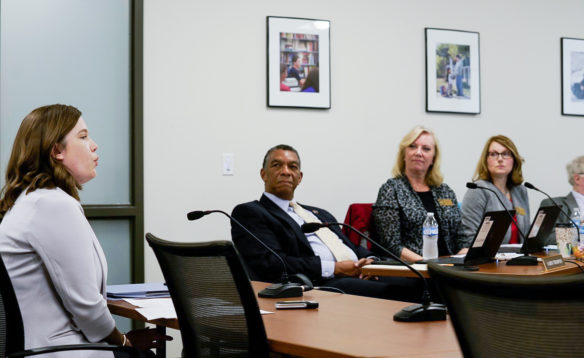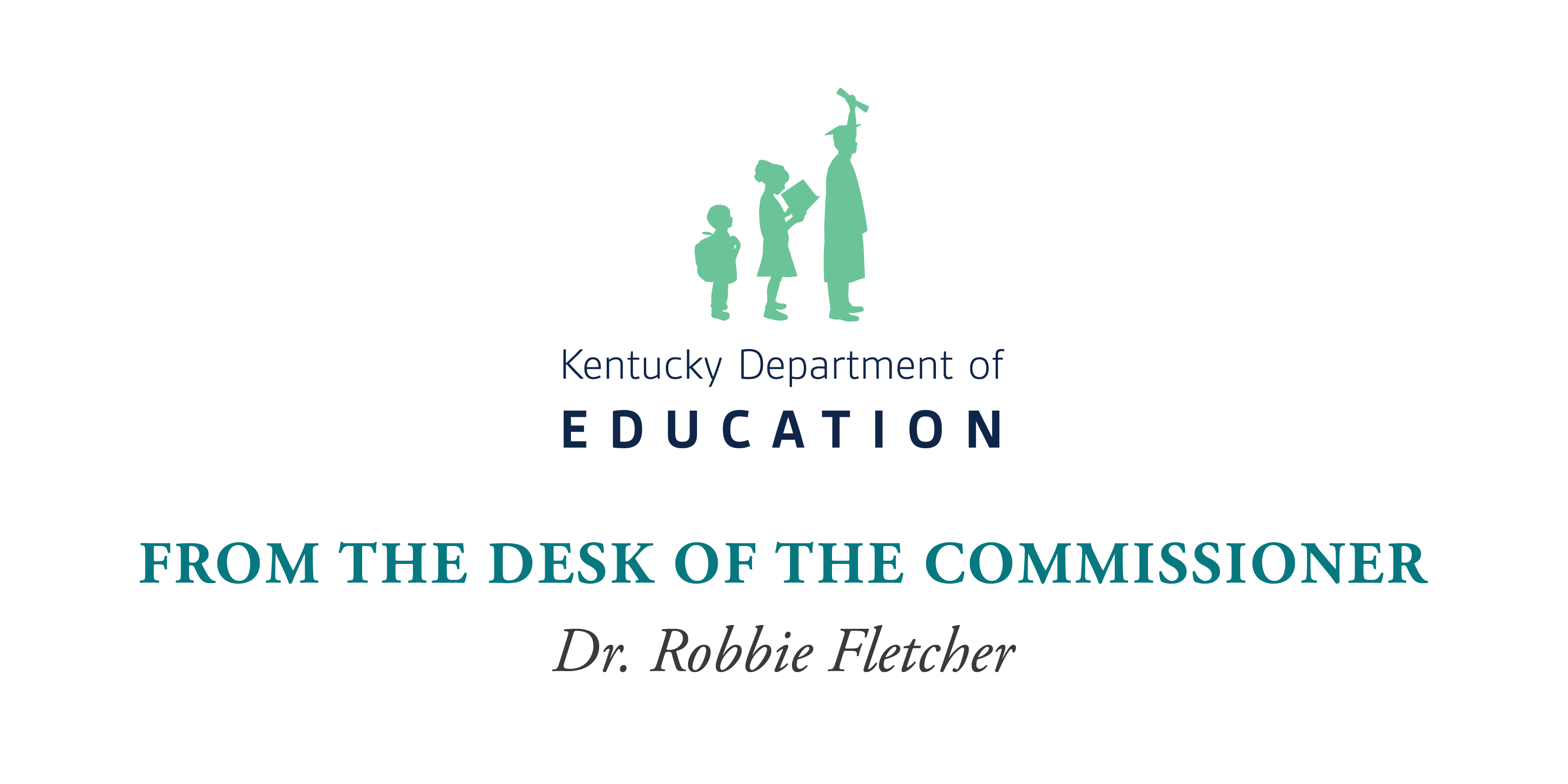
Erin Ball, Kentucky’s 2020 Teacher of the Year, was introduced to the Kentucky Board of Education on Feb. 4. She is a language arts teacher at Georgetown Middle School (Scott County) and is on a six-month sabbatical with the Kentucky Department of Education.
Photo by Marvin Young, Feb. 4, 2020
Editor’s note: Erin Ball, Kentucky’s 2020 Teacher of the Year (TOY), was introduced to the Kentucky Board of Education (KBE) on Feb. 4. The following are her comments from the meeting. Ball is a language arts teacher at Georgetown Middle School in Scott County. She is currently on a six-month sabbatical with the Kentucky Department of Education.
Hello and good morning. I want to thank you for hosting me. As the 2020 Kentucky Teacher of the Year, I am honored to serve as an ambassador for public education in Kentucky. I am passionate about promoting the profession because I believe teaching is an honorable and rewarding career and a significant and worthwhile investment.
I come from a long line of teachers. Both of my great grandmothers taught in a one-room schoolhouse, children from 1st through 8th grade in Mason County. My great aunt taught elementary school for 31 years. My grandmother taught Sunday school for over 20 years. My mom was a public school teacher and taught middle school math for 31 years. My younger sister is in her first year of teaching 3rd grade in Kenton County and my younger brother is currently student teaching in Grant County.
In addition to my family, a lifelong love of reading and learning cultivated early in life by several impactful teachers influenced me to become a teacher. In 2nd grade, Mrs. Crabtree introduced me to a whole new world through books. Early on, she noted that I had an interest in reading and she encouraged that interest in every way possible. She asked me about my preferred genres and favorite books. She checked up on what I was reading each week, offered book suggestions based on my interests and challenged me with higher-level books. I blossomed as a reader because of Mrs. Crabtree.
Inspired by Mrs. Crabtree’s influence in my life, I endeavor to instill and foster a love of reading in my 8th-graders. My favorite way to connect with my students is by connecting them to books they will love. I relish the moments when my students return after they’ve finished a recommended book and want to talk about it or ask for another. For me, this is the most rewarding part of teaching.
Currently, I am pursuing my library science degree at Eastern Kentucky University (EKU) with the hopes of one day becoming a middle school librarian.
Through my studies at EKU and an influential professional development by one of my favorite authors –Donalyn Miller – I began in my third year of teaching trying to understand the importance not only of connecting my students to books, but also the importance of providing them access to diverse books.
Once I began to realize the importance of giving my students access to texts and characters to which they could relate, I set out to fill my classroom library with more diverse literature.
I searched used bookstores, Goodwill, Scholastic book fairs and used my classroom funds to get as many books as I could that reflected the diversity of the students sitting in my classroom. As I began to see more and more students respond positively and request these books specifically, I set out to get more.
Everyone benefits from diverse literature.
Reading books from many voices and perspectives not only fosters empathy and awareness, but it also helps to develop our students into inclusive citizens who value diversity and who care about the world and other people. Everyone wants to be able to see themselves in the stories that they read.
I believe all children deserve to see themselves and their families in the stories that they read. It’s important that we communicate to all our students that their stories matter.
In a January 2019 report from The Council of Chief State School Officers (CCSSO) entitled “A Vision and Guidance for a Diverse and Learner-Ready Teacher Workforce,” the authors write: “Students benefit from mirrors and windows — the mirror representing the story that reflects their own culture and helps them build their own identity, and the window that offers them a view into someone else’s experience.”
Those mirrors and windows come not only from literature, but also from teachers. Research overwhelmingly supports that students benefit from having a diverse group of teachers that come from a variety of backgrounds.
Research also shows that students’ exposure to people who are different from them leads to improved cognitive skills such as critical thinking and problem solving. Regular interactions with individuals from a variety of races and ethnic groups, especially in childhood, can also help combat stereotypes and reduce implicit biases inside and outside of the classroom.
In the CCSSO report, Sarah Leibel, a lecturer on education and master teacher in residence in the Harvard Teacher Fellows Program, said in addition to windows, “it is also important for our students to have mirrors; people who reflect back to them their language, culture, ethnicity, religion.”
My own experience in school was sadly lacking in diversity. Looking back on my own education, I don’t recall having a single minority teacher ever in my K-12 experience. I had plenty of teachers that looked like me. Lots of mirrors and not nearly enough windows.
Far too many of our students across the Commonwealth are severely lacking windows or mirrors. The lack of a racially diverse teacher workforce is a critical equity issue in our state. During the 2018-2019 school year, minorities made up 23.9% of our student population, but only 4.8% of our teacher population.
The future of Kentucky depends on us recruiting high-quality teachers. If we want to ensure that every student of every race and ethnicity and background in Kentucky has access to a world-class education, then we must make meaningful strides toward increasing the racial diversity of our teacher workforce.
I’m still working on what my best contribution toward this end will be, but a big part of my platform will be partnering with the efforts of others doing the important work of helping to ensure our teacher population better matches our student population across the state.
There are several wonderful initiatives and programs in Kentucky right now aimed at increasing the number of minority teachers through recruitment and retention. I have been and hope to continue exploring these initiatives to learn more about the common barriers to minority recruitment as well as sustainable solutions.
So far, my exploration has taken me to Jefferson County. I am working with Donna Melton, the coordinator of the Kentucky Teacher of the Year program, to schedule additional learning sessions in Murray, Bowling Green, Hopkinsville, Covington, Lexington, Frankfort and other districts where minority recruitment and retention is of paramount focus.
I appreciate any suggestions you might have on who I should meet in the areas you represent, both inside and outside of the school environment.
I challenge myself to return at the end of my ambassadorship to share with you what I have learned.
Thank you.




Leave A Comment